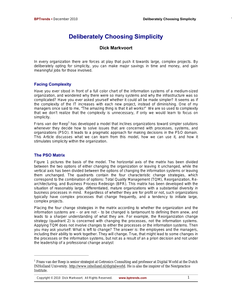To perform at top level, all systems within an organization need to be aligned. When body and mind aren’t connected, you can’t function well. In the same way that it is important to align the mind and the body, a promising business vision (the mind) will not have the expected result when executed without the alignment of all existing parts of the organization (the body). You have to choose how this vision will fit in. People will experience complexity when new references do not fit in with their existing references – hence, the need for taxonomy to connect the dots and internalize external references. The Company Reference Grid (CRG) is this taxonomy for enterprises and was originally designed by Frans van der Reep [1]. This extended alignment tool combines business, ICT, HRM, and operations from a strategic, entrepreneurial, and operational capabilities point of view.
DOCUMENT

Internet dwingt u om nieuwe keuzes te maken die de sociale samenhang in uw organisatie verandert, Frans van der Reep heeft met de Company Reference Grid (CRG) een manier van werken ontwikkeld, waarin eenvoud en verbondenheid optimaal tot hun recht komen. De CRG is een zeer praktisch en nuttige tool gebleken om bedrijven mee te nemen in vernadering. Bovendien zorgt de eenboud er voor dat men eerder klaar is. Voor het visueel maken van samenhang en samenwerking geeft houvast. Ondanks dat alles in dit grid in hokjes is ingedeeld, doorbreekt dit juist het ''hokjesdenken' en kijkt men over de eigen grenzen heen. Deze krachttermen zijn in de organisatie eenvoudig te communiceren en snel herkenbaar voor iedereen. De CRG is zeer veelzijdig en kan daarom niet volledig worden beschreven. De toepassingen, zoals HR-competentieoverzicht, projectplan, informatie- en documentatieoverzicht en BBSC, zijn slechts enkele voorbeelden. Bij gebruik van de CRG vindt men waarschijnlijk nieuwe toepassingen en maakt het geheel nieuwe zaken inzichtelijk.
DOCUMENT

This Article presents the PSO matrix as a tool for making choices in change projects – choices for simplicity or for complexity. A good process structure is essential for a simple organization, but it is the employees and the managers who are expected to take the lead in the changes and the improvement proposals. The PSO matrix is a useful and usable instrument that promotes simplicity and respects the intelligence that is already present in the organization, particularly that of the ordinary employees. The approach leads to drastic savings. Do as much nothing as possible.
DOCUMENT

The definition of ‘Assistive Technology’ (AT) includes both assistive products and the services or actions necessary for safe and effective provision of the assistive products to people who need them. International standards and product specifications exist for assistive products. Despite huge unmet need for effective AT provision, a variety of service delivery models across different countries, and a shortage of personnel trained in this field, nowidely useable and accepted AT service provision guidelines currently exist. Aligned with contemporary global initiatives to improve access to AT, a scoping review was commissioned to inform the development of globally useable provision guidance. The aim was to deliver a rapid scoping review of the literature regarding quality guidelines for AT service provision. Method: The rapid scoping review utilised a two-tiered approach to identifying relevant publications: 1) systematic search of academic databases; 2) consultation with assistive technology organisations. The review was conducted in March 2023 across four databases (Medline, CINAHL, SCOPUS and Google Scholar) with no date limitations. Systematic outreach to international and global AT networks was used to access expert informants. Non-English publications were included utilizing Google Translate and support from expert informants to verify content. Analysis was guided by the body of work on quality AT provision and service delivery processes in Europe, as well as the World Health Organization-GATE 5P framework for strengthening access to AT. Results: The search strategies yielded 41 publications from diverse countries, and directed at differing assistive products, personnel and provision contexts. Results are reported from the charted data through to the data extraction framework, including type of publication, study design, audience and reach. We report on the type of AT and the AT provision ecosystem elements discussed, and service delivery process or steps and quality criteria service delivery. Conclusion: This review did not find established guidelines or standards for service provision, but it did identify key service delivery steps which may form part of such guidelines, and many of the 3 publications included mentioned the need for practice guidelines. Despite different contexts such as type of assistive product, recipient of the guidance, language, location and authorship, core elements of AT provision including service delivery steps can be identified. Consideration regarding the nuances of vocabulary, of process, and of enabling flexible foci, is recommended in systematizing globally applicable guidance. This review offers a strong starting point for developing guidance for assistive technology provision to meet global need.
DOCUMENT

This Article presents the PSO matrix as a tool for making choices in change projects – choices for simplicity or for complexity. A good process structure is essential for a simple organization, but it is the employees and the managers who are expected to take the lead in the changes and the improvement proposals. The PSO matrix is a useful and usable instrument that promotes simplicity and respects the intelligence that is already present in the organization, particularly that of the ordinary employees. The approach leads to drastic savings. Do as much nothing as possible.
MULTIFILE
